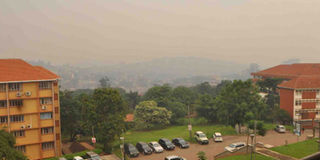Alarm as air pollution levels exceed WHO limit

A hazy sky above Kololo hill in Kampala last Wednesday. PHOTO/ STEPHEN OTAGE
Emerging evidence has linked the smoggy skylines being observed in several towns and cities across the country to high levels of pollution.
The display that started last week has triggered health anxiety among residents.
The fear about the hazy skylines was worsened by the Kampala Capital City Authority (KCCA) announcement last Monday that they detected pollution several times higher than the World Health Organisation (WHO) normal range of 25 microgram per cubic meters.
“Results from our 23 air quality monitors across the city in the last 28 days indicate that average particulate matter (PM 2.5) is at 75 micrograms per cubic meter, [which] is 3 times higher than the World Health Organisation (WHO) cut off,” the KCCA said in a tweet on February 7.
Particulate matter (PM) is the sum of all solid and liquid particles suspended in air many of which are hazardous to human health. PM2.5 are the fine inhalable particles.
AirQo, a Makerere University project that collects and analyses air quality data using cloud-based technologies, confirmed that their analytics for Kampala area indicate that PM2.5 levels have been largely within ‘unhealthy and very unhealthy’ zones of the Air Quality Index (AQI).
“By 7am on Tuesday, air quality levels varied from 60-200 microgram per cubic meters and had reached 300 microgram per cubic meters in some areas. These levels fluctuate during the course of the day,” AirQo said in a tweet.
This means some residents were exposed to pollution levels more than five times the WHO normal range.
During the lockdown last year, AirQo reported that air quality had improved by 40 per cent. In an interview yesterday, Mr Deo Okure, the air quality scientist at AirQo, said the pollution is due to changes in the season and human activities.
“We have been closely monitoring the air quality (in Kampala) for the last couple of days. From Thursday last week, the skylines had been smoggy. We compared with what is happening in other cities across the world and it looks like it is a localised problem [only in Kampala],” Mr Okure said.
According to experts, although this period is supposed to be a dry season, it has rather been raining in January.
“Calm weather situation such as less wind tends to trap pollution closer to the ground because it cannot be dispersed. It is such pollution closer to the ground that affects people and it is what the machines detect. When there is high humidity, it causes the [dust] particles to swell. But if the air is very dry, it is easier for dusts to form,” Mr Okure explained.
Dr William Worodria, an expert in respiratory diseases at Makerere University Lung Institute, said the biggest drivers of pollution in the country are emissions from industries, motorised transport and cooking using biomass or wood fuel. “If we had cheaper electricity, people would use less biomass. Some of the pollutants are silica from roads, so if they can tarmac the roads, it will reduce on the level of those pollutants,” Dr Worodria said.
KCCA said last Monday their “team is working on source apportionment and emission inventories to ascertain the contribution of each sector and how to deal with it.” Dr Daniel Okello, the head of Public Health and Environment at the KCCA, could not be reached for details by press time.
However, Mr Tony Achidria, the senior public relations officer at the National Environment Management Authority (Nema), said they are increasing efforts to curb pollution in the country.
“Much of the pollution is caused by old vehicles, those which are not serviced well and boda bodas. You realise that the air quality was much better during the lockdown when boda bodas and vehicles were not allowed to move compared to when they were operating,” Mr Achidria said.
“Also, there is an assumption that pollution of the air is caused by emissions from industries. But our findings have indicated that the industries are well regulated and their emissions are very low,” he said. Daily Monitor couldn’t independently verify this.
According to Mr Achidria, the industries are monitored regularly and they are parameters that they have to follow in terms of what they can emit.
He said the agency has also put in place a law that bars importation of vehicles older than five years.



